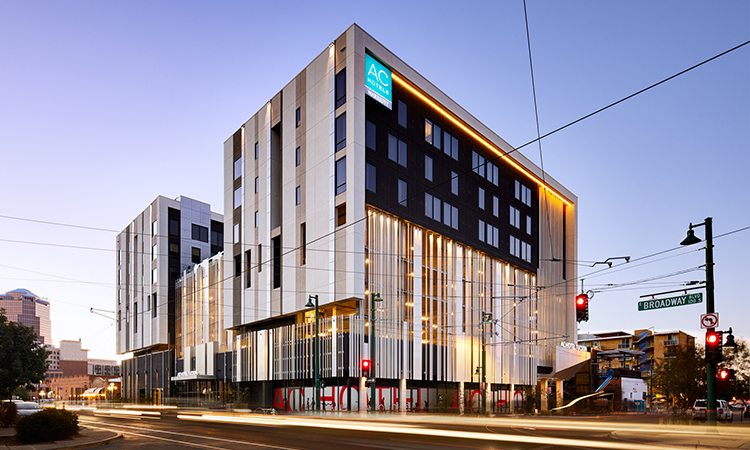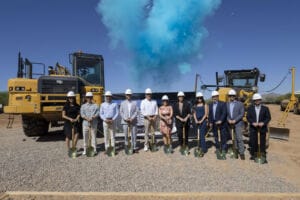March ranks as the biggest month for Arizona’s hospitality and tourism industry, which was Arizona’s top export industry in 2016, according to the Arizona Office of Tourism.
Great weather, sunshine and annual tourism attractions like the Cactus League Spring Training season and the Waste Management Phoenix Open definitely help, but Arizona has also become known for fun in the sun all year round and much more.
The Office of Tourism reports Arizona enjoyed the company of 43 million visitors in 2016. Those visitors collectively spent $21.2 billion in the state, which pencils out to more than $40,000 being spent per-minute by out-of-staters that year.
To capitalize on Arizona’s tourism popularity and large crowds for other mega events previously hosted in Metro Phoenix like the NCAA National Football Championship, NCAA Final Four Tournament and Super Bowl, new commercial real estate projects have emerged in the form of new attraction and entertainment hubs that have either been recently completed, under construction or being planned.
In fact, there was approximately $594 million worth of hospitality construction in Arizona last year, which accounted for 5.83 percent of total market construction activity, according to AZBEX’s 2018 construction forecast.
Arizona already has a lot to offer in terms of its natural beauty with tourist destinations like the Grand Canyon, which boasted nearly six million visitors in 2016. However, since Metro Phoenix doesn’t have an original Wonder of the Natural World, other strategies are being deployed such as new hotel projects and renovations to keep up with market demands and drive industry growth.
Another trend catching on across the Valley is how to thoughtfully incorporate new hospitality developments with existing ones to increase foot traffic and an area’s overall attractiveness as an entertainment hub for people of all ages.
In recent years, hotels have been integrating offerings with local attractions, says Dr. Claire McWilliams, a hospitality and tourism instructor at ASU’s School of Community Resources and Development.
“Why settle for being a ‘place to sleep’ while tourists find entertainment and attractions elsewhere?” McWilliams asks. “Many Metro Phoenix hotel properties have chosen to creatively use their space for entertainment venues.”
These attractions can be anything, from hosting seasonal events, to pool parties or concerts at the hotels, McWilliams says.
Those draws are not limited to the grounds of the hotel or resort though. Large hospitality hubs have been cropping up in the Valley, creating “attraction corridors,” McWilliams says.
One prominent East Valley example that continues to grow and attract new places to shop, dine, play and stay is Scottsdale’s Talking Stick Entertainment District, which is located within the Salt River Pima-Maricopa Indian Community.
The entertainment hub is already home to amenities such as Talking Stick Resort, Salt River Fields at Talking Stick, Topgolf, and most recently OdySea in the Desert – a 35-acre, multi-million-dollar entertainment destination with approximately 20 restaurants, retail and amusement establishments.
Here, residents and visitors can stay at the resort to catch a nearby Spring Training game, round of golf or make their way to America’s largest butterfly conservatory called Butterfly Wonderland, the Southwest’s largest aquarium at OdySea Aquarium or swim with dolphins in Arizona’s largest salt-water pool at Dolphinaris Arizona, to name a few.
The latest attraction to break ground in the area is the Great Wolf Lodge, which will include an 85,000-square-foot waterpark and 27,000-square-foot family entertainment center located on an 18-acre lot adjacent to Salt River Fields at Talking Stick.
Downtown Phoenix has also tapped into the trend described by McWilliams. As the area has grown in popularity, so has the number of hotels offering boutique, hip experiences.
Recent projects like FOUND:RE in the Roosevelt Row Arts District have brought a hip and vibrant, culture-based staying experience to the area by featuring public art displays that rotate throughout the year.
Other hotels currently under construction like the $33 million, 210-key Hampton Inn & Suites in Downtown Phoenix will also integrate into the area’s urban identity with a focus on community as well. In total, more than 530 hotel rooms will be added and opened in Downtown Phoenix during 2018 on top of the existing 3,199 rooms.
The developers of the Hampton Inn, Mortenson Development Inc., chose the hotel’s location near the center of Downtown Phoenix, by the ASU Campus, for the larger ecosystem around the hotel that offers a very immersive mix of demographics from visitors to students and professionals from the private and public sectors. And that ecosystem is thriving as the Downtown Phoenix area has grown exponentially over the last decade with more fun restaurants, venues and events to go to.
According to Downtown Phoenix Inc., more than 180 restaurants and bars are located in Downtown Phoenix and the area’s arts, culture and sport venues draw in a total of over six million visitors each year.
“It’s more about the ecosystem that’s around you,” says George Forristall, development executive at Mortenson. “And that’s why the Hampton is in a downtown urban environment, where it’s very walkable, so you’re not in a suburban hotel and you have to get in a car to drive to everything.”
This focus on creating a hotel that’s tied to the public is stretching into other parts of the Valley as well. In Scottsdale, the recently renovated Hotel Adeline opened and anticipates it will become a hangout for locals, says Shaun Baker, general manager of Hotel Adeline.
The place has a warm and approachable atmosphere that he likens to a friend’s house.
“Of course, we want guests to experience clean, comfortable and beautifully designed accommodations along with excellent services,” Baker explains. “Beyond that, we hope the impression is that we’ve created a welcoming, eclectic and low-key environment where our guests can kick back, relax and enjoy a completely unique experience.”
Hotels that are stodgy and almost royal are becoming less common as more boutique hotels, offering 100-rooms or less, come online throughout Arizona, especially Greater Phoenix.
Many of these hotels are boutique properties, meant to feed the public’s desires for lodging that’s more different than what we commonly think of as hotels, McWilliams says.
Like the $20 million hotel currently under construction in Uptown Phoenix. The innovative adaptive reuse project by Vintage Partners and Venue Projects will transform a pair of architecturally significant yet long-neglected midcentury modern mid-rises into Uptown Phoenix’s newest dining, entertainment and urban hotel hub.
Named Arrive Phoenix, the stylish, 79-room boutique hotel will also feature a boutique coffee shop, poolside taco bar, gourmet ice creamery and a nautical-themed rooftop craft cocktail bar featuring sweeping 360-degree city views.
Overall, an emphasis on a destination’s sense of place can be seen in Instagram and Facebook feeds, and many local developments and hotels have been working towards catering to this niche with unique spaces folks of all ages and backgrounds will enjoy.
“The Camby, the industrial-artsy FOUND:RE in the Roosevelt Arts District in Downtown Phoenix, the Hotel Adeline in Scottsdale… all of these re-toolings and newbies speak to the novelty and sense of place niche hotels offer,” McWilliams says.
The new shape of hotels
The Greater Phoenix region has been adding many new hotel developments, while many other hotels receive brand-new face lifts. Here’s a breakdown of some of the latest hotel deliveries and renovations.
AC Hotel Downtown Phoenix at Arizona Center
In addition to renovations currently underway at the Arizona Center, a 15-story, 200-key AC Hotel will be added that’s urban-inspired and overlooks a three-acre park.
AC Hotel Tucson Downtown
Downtown Tucson’s first hotel in more than 30 years, this AC Hotel Tucson by Marriott delivers unobstructed views of the city, an open-air pool, full-service bar and easy access to historic theaters, retail shopping and public transit.
Hampton Inn and Suites
Slated for completion this summer, the Hampton Inn and Suites in Downtown Phoenix will utilize the area’s walkability while also adapting to the community. This hotel will feature local artworks and embrace the character of the Southwest. Guests will truly feel like they’re in an urban environment with easy access to the local food scene and light rail transportation.
Hotel Adeline
Formerly known as the Scottsdale Inn, Hotel Adeline is a boutique hotel all about chic, sleek, uncomplicated designs meant to make guests and locals feel at home. Modern wood furniture with that retro vibe adorns the hotel and there’s also a zero-edge pool that will be the centerpiece of Hotel Adeline.
Residence Inn/Courtyard by Marriott Phoenix Downtown
Designed to blend in with the historic, neighboring Luhrs City Center, the dual hotel project towers 19 stories above Phoenix. The building has 320 rooms between the Residence Inn and Courtyard by Marriott. This project is playing a major part in the revitalization of this part of Downtown Phoenix and of the Luhrs City Center, which was originally built in the 1920s.
The Scott
The Firesky Resort & Spa has been rebranded into the Scott as a $15 million renovation reshapes this space. The first phase of the renovations changed the lobby areas, restaurants and outside patios, playing with the original, classic architecture while giving The Scott a new look and feel. Next, the guestrooms are getting touched up with new furniture, redesigned bathrooms and an all-new Presidential Suite.










